Hokepoints Never Really Knew Purdue Anyway

[Bentley]
It's was sunny and lovely out yesterday in Michigan. Sunday night's storm swept the humidity aside and deposited rain where it belongs: on my lawn. So why did it feel like that sun was a little darker, that sky a little hazier, this July a little less nice than the June that preceded it? Oh, right.
The first official piece of Maryland @bigtenconf apparel presented to @kbaterp and Commissioner Jim Delany! pic.twitter.com/zHpA2Nul6X
— Maryland Athletics (@umterps) June 30, 2014
It's official: our moms are forcing us to play with Scott Malkinson.
Why is this happening again? Well they're joining for the money: both schools have had relatively bad athletic departments who over-leveraged themselves in the big sport facility and coaching arms races, Rutgers less so than Maryland, but then Rutgers was about to wind up trapped in the sinking ship of the Big East/American. Maryland has massive debt from its building projects and the ACC ain't gonna pay them, so they were ready to whore themselves out to whichever conference came along, even if it meant an end to their relationship with Duke.
(No, Penn State fans don't care about either as rivals.)
The real question is why in the heck we'd want them. It's cable TV. Starting with the Big Ten, the big conferences have been getting in on the great scam of cable bundling. Cable providers have monopolies in their markets, and are second only to the military-industrial complex in political spending, all so they can force subscribers into all-or-nothing tiers of hundreds of channels to get one they want (and try to charge people extra to not get their internet slowed).
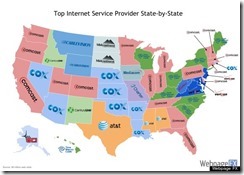 |
| Big Ten's Expansion Plan: rip off the cable companies after they rip off America. [Image credit: HuffPo] |
This works out very well for the cable giants but leaves them a particular vulnerability to any network with a sports license. Fiercely loyal college football fans will scream at their cable providers if they can't watch the game, and advertisers lust after sports because they're the last of the DVR-proof live events, so cable providers pay out the nose for the network with the game. Then they place that network on a relatively accessible tier that everybody in that market must pay for, and raise prices accordingly.
In this way, if there are just enough A&M fans in Dallas, every cable subscriber in Dallas will pay an extra $5/month to the SEC and its partner (ESPN). If there are just enough Missouri fans in St. Louis, if there just enough Maryland fans in D.C. metro area, if there are just enough Rutgers fans in New York City, etc. The Big Ten schools are gambling on there being enough Rutgers fans to scam $5/month from everyone in New York. So far they've already got New Jersey and Maryland.
The gamble for the schools is they think they'll sell out the stadiums no matter who's visiting, so who gives a damn if it's Maryland visiting instead of Wisconsin. The fans aren't going to see a dime of the Comcast deal (at least not at Michigan—most schools are a little less adversarial to their fans) and just have to decide to put up with the new faces, or not.
In the list of downsides, there are worse things that can happen than having Wisconsin disappear forever, or the invention of more derived, ugly trophies. So long as it ends with Ohio State and MSU is in there, it's a Michigan season, while any Notre Dame or Minnesota you can sprinkle in is appreciated. To put the loss in context I thought I'd look through Michigan's history with the conference with respect to the frequency we've faced various conference rivals.
A History of Western/Big Ten Conference Scheduling
Early years (1892-1906): Prior to the invention of the conference, Michigan already played some of its future rivals. They played Chicago twice in 1893 (both on the road), and even after joining the conference Michigan had an extra (non-conference) game against Chicago's med students.
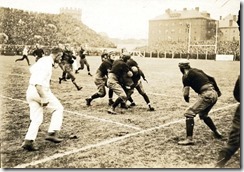 |
| Hey, just 'cause we left you guys aren't supposed to be rivals. [Chicago vs. Minnesota in 1916.] |
There were seven teams in the original 1896 conference—Michigan, Wisconsin, Illinois, Minnesota, Northwestern, Purdue, and Chicago—with Indiana and Iowa joining in 1899. Teams customarily only played games in October and November, and Michigan played anywhere from two to five conference opponents a year. The 1906 team (the last before leaving the conference for a time) played just one conference game (Illinois) among five games plus an alumni exhibition.
If there was any pattern to this, it's that Michigan and Chicago would play every year except 1899 and 1906. There were a few stretches of other rivals lasting not more than four years. The newcomers (Indiana 1900-'03, Iowa 1900-'02) apparently were guaranteed some starter games with Michigan. Wisconsin (1899, 1902-'05) was the next-most regular. Northwestern and Michigan only played twice before M left. Once we did, we played Minnesota twice but nobody else.
[after the jump, we lose Chicago, gain worse]
Next Early Years (1917-1952): Getting back to a Big Ten schedule was slow. The 1917 team already had a full schedule they didn't want to cancel on, so they added Northwestern (on 11/24) at the end of the year and that was it. In 1918 because of the influenza epidemic and wartime travel restrictions, Michigan had to cancel a bunch of games, knocking off conference foes Northwestern and Minnesota and rescheduling Ohio State at the end of the season (11/30). The Chicago game was unaffected.
Notably that season Michigan also made a point of scheduling Michigan Agricultural, i.e. State. For years before MSU joined the Big Ten this was a non-conference rivalry. They played in 1918, 1925, and every year after that.
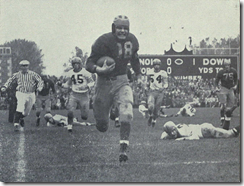 |
| After this game-winner vs. Illinois in '47, Bump Elliott went 9-1 versus the Illini as a coach (6-1 vs. brother Pete). |
From 1919 to 1931 Michigan played between four and six conference games (the league voted to make four the minimum after 1925). The Wolverines made sure that Ohio State and Minnesota were on the docket every year (twice in 1926 because the Gophers were so desperate to meet their 4-game quota that they agreed to drop their offense), and played Illinois every year except 1923. Wisconsin they skipped four times, Chicago they played just five against, Iowa was seen four times, Indiana and Northwestern thrice, and Purdue twice.
Starting in the 1930s Michigan usually had six and and never less than five conference foes a year except when Chicago suddenly dropped football, leaving the 1940 schedule at four. The rivalries that were respected through the '30s and '40s were OSU, Minnesota, and Illinois, played every year. Chicago took a two-year hiatus in the mid-'30s before they dropped out, and Northwestern only missed two seasons ('35 and '39) in 20. Indiana became a regular rival in '43. Iowa and Wisconsin (7 games each in two decades) and Purdue (5) were off the schedule far more often than not.
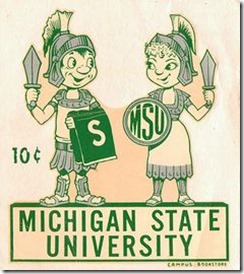 |
| MSU joined the conference in 1950 and started play in 1953. Before that Michigan was just playing them anyway. |
The Big Ten Years (1953-1992): In the post-war period MSU joined the conference and Big Ten teams settled into nine-game seasons with a minimum of six conference games. Michigan played at least seven every year but 1953 (Penn was scheduled for homecoming on Halloween), and 1961, when Duke could only schedule in early November (football still didn't start until the last day of September). Seven games was standard after '62, and starting in 1971 everyone in the conference had to play eight (several schools went up to nine on occasion). In 1981 and '82 Michigan was among eight schools who went to nine games. The Big Ten expanded to a full round-robin of nine for the next two seasons, but that went back to eight after the '84 season.
Under the '84 rules and the pre-'81 de facto rules, somebody had to be left off the schedule, and again for Michigan this was weighted. The every-year rivals were Ohio State, Minnesota, Michigan State, and Illinois. Iowa and Northwestern rotated off a total of 10 times each. The longest we went without seeing either was four years when Iowa dropped in the mid-'60s. Indiana was on the same program as those guys after a six-year hiatus in the early '60s. Purdue and Wisconsin were ignored for the early part of the '50s, but got on the same kind of rotation thereafter. Once the Big Ten went to an eight-game schedule you'd miss the non-rivals for two consecutive seasons every two decades.
 |
| This is when we stopped being good at counting. |
The Big11Ten Years (1993-2010): The Big Ten went to 11, but kept its eight-game schedules. The way it worked out was to have each team select two rivals to play every year, and the other teams rotate off for two seasons in eight in pods. For Michigan the rivals were Ohio State and Michigan State, and the pods were initially (in order) Indiana-Northwestern, Iowa-Wisconsin, Minnesota-Penn State. Again the new guys were guaranteed a long series with Michigan to start their Big Ten-ure. But they switched the pods around after the 1998 season (no idea why--the rumor around the Daily was Penn State didn't want Michigan to drop off the schedule). Thereafter Iowa was on Minnesota's schedule, and Penn State was of a pod with Wisconsin.
As a result Michigan faced Penn State all but the 2003 and 2004 seasons, saw Illinois, Minnesota, Purdue, and Wisconsin all but four of 18 years, and wound up with just 12 games in that period against Indiana, Iowa, and Northwestern.
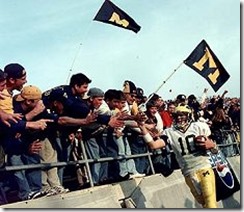 |
| Michigan had to go back to Penn State in 1999 once the pods were screwed with. So we did that. |
The Successories Years (2011-2013): Adding Nebraska created the stupid motivational poster divisions, with a designated annual rival from the opposite division. Michigan and Ohio State were put in different divisions and made each others' annuals, a situation that put Michigan's schedule likely to be tougher than that of teams they'd regularly be in divisional races with, particularly MSU. It also meant just two games left to play the five non-rivals in the other division, so they'd be off the schedule 60% of the time.
Divisional rivals were Iowa, Michigan State, Nebraska, Minnesota, and Northwestern. The alignment only lasted three years, so Illinois and Purdue fell off just once, Indiana and Penn State were gone two of three years, and Wisconsin disappeared.
The Future (2014-??): A bloated 14-team conference means six games are spoken for by divisional rivals. In 2016 the Big Ten will at least go to a nine-game schedule, because fitting seven cross division rivals into two spots was going to make the other division essentially a separate conference. It's not exactly 2/7 (or 3/7 after 2016) because Purdue has a protected game with Indiana, and the Big Ten said straight-out they don't plan on having an even rotation; rather they'll schedule things based on who hasn't seen whom, with greater respect paid to rivals.
I figure by that they mean Minnesota will hang around more often but Illinois probably won't. Games through 2019 are currently scheduled. From this September till then, provided the conference isn't expanded further, Michigan will play Wisconsin four times, Minnesota and Northwestern thrice apiece, have two games with Illinois and Iowa each, and play Nebraska once. Purdue is officially somebody we used to know. Or didn't know. Chart of familiarity?
In 2019 Ohio State will catch Minnesota for our most-played Big Ten rivalry. Greg Dooley will probably be upset about it.
Scott Malkevich = Scott Malkinson? (I assumed it was a South Park reference)
right.
FYI, the Big Ten Network doesn't get anywhere close to $5 per subscriber. Most reports have them getting a dollar in the B1G footprint, and a dime outside the footprint. At $5.54 per subscriber, only ESPN is in that $5 ballpark. And as far as regionals go, YES gets around $3/subscriber in the New York area.
But in general, the whole Rutgers/Maryland move was all about adding TV markets. With those additions, the Big Ten has NYC, Chicago, Philly, Washington DC, and Detroit in their footprint. Five of the top 11 markets. No other conference has more than two of the top ten (although if you want to stretch and give the SEC both Dallas and Houston, then they have three). When the TV deal is up in 2016, it'll create huge amounts of income for the schools. So in addition to extorting huge amounts of money from ESPN/Fox/Whoever, they might also be able to leverage their network into getting something like $2 a subscriber in the footprint.
After reading that section I am reminded how much I dislike how money defines all the decisions in this country and why everything is completely corrupt. That was a sad realization. What's the little guy to do?
not so rare
google "too big to fail"
:)
thanks for the research
I hear ya, and of course you're right. But, if you're like me in the Northeast your only option if you want to catch UM games (other than against the other national brands) is to purchase the B1G network or deal with crappy internet feeds. It's hard when you feel like your passion for the product becomes part of the problem.
Colleges exist to educate, not entertain, but football proved so wildly popular that the temptation to maximize revenues has been a constant problem.
College football history is littered with reform movements seeking to rein in its commercial aspects. Unfortunately, it is a problem that can only be contained for a while, without ever being solved. The only things we can do as fans is vote with our feet and wallets: turning off the TV, refusing to pay excessive prices for game tickets, and not buying overpriced souvenirs.
It's hard when on the one hand you have a strong dislike for the commercialism for the sport, but on the other hand you passionately love for the product. Taking away all the commercialism also probably takes away some the the quality of the product. The big qeustions is where do you draw the line and what is the happy medium? I have no idea. And, I'm part of the problem. I just can't get enough UM football no matter how much I dislike what my dollars do.

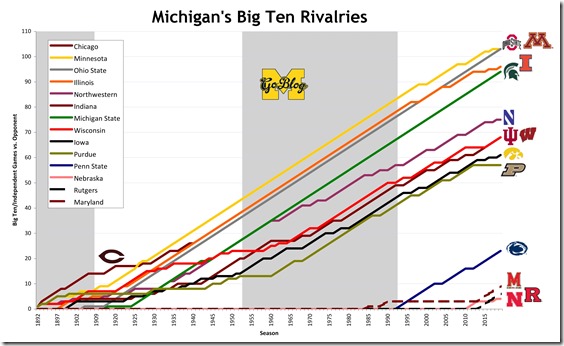
Comments